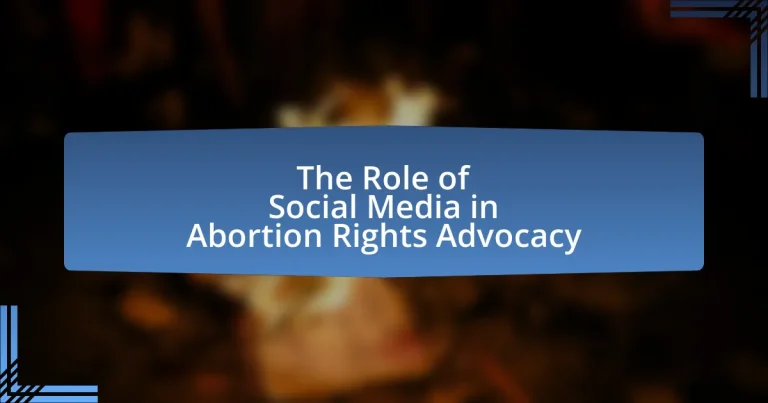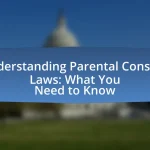The article examines the significant role of social media in abortion rights advocacy, highlighting how platforms like Twitter, Facebook, and Instagram facilitate communication, mobilization, and awareness around reproductive rights issues. It discusses the transformative impact of social media on advocacy efforts, including the effectiveness of campaigns such as #ShoutYourAbortion, and the influence of different demographics on engagement. The article also addresses challenges faced by advocates, such as misinformation and censorship, and outlines strategies for combating negative narratives. Additionally, it explores the importance of visual content, personal stories, and data analytics in enhancing advocacy efforts, while identifying future trends and best practices for effective engagement in the realm of abortion rights.
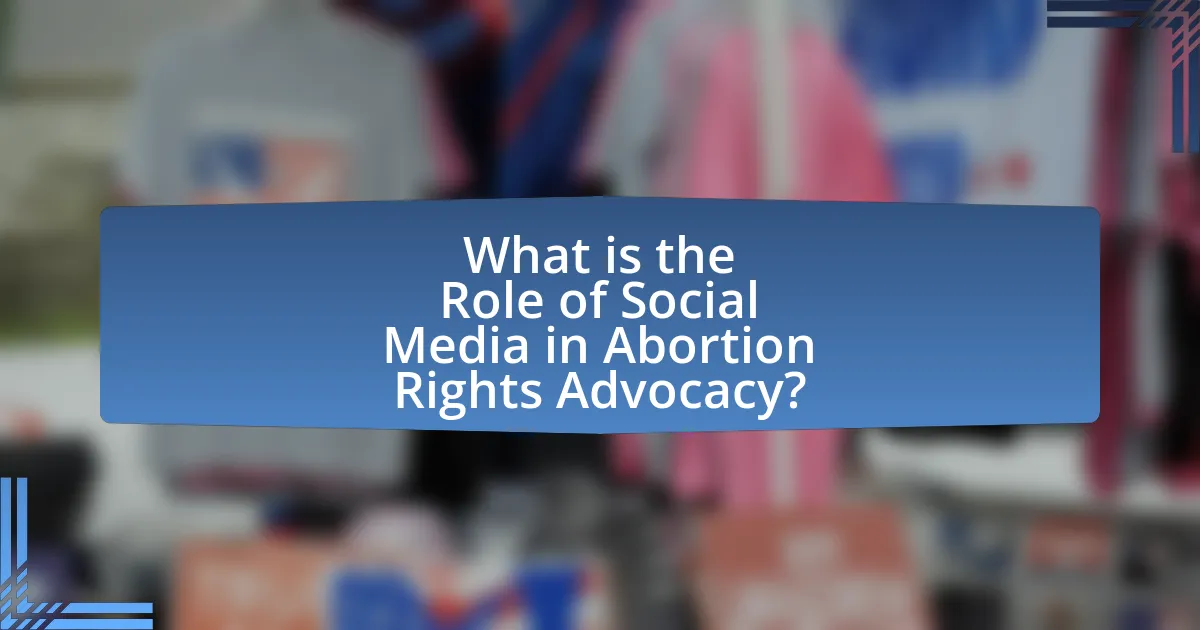
What is the Role of Social Media in Abortion Rights Advocacy?
Social media plays a crucial role in abortion rights advocacy by facilitating communication, mobilizing supporters, and raising awareness about reproductive rights issues. Platforms like Twitter, Facebook, and Instagram allow activists to share information quickly, organize events, and connect with a broader audience. For instance, the #ShoutYourAbortion campaign has empowered individuals to share their personal stories, reducing stigma and fostering community support. Additionally, studies show that social media can significantly influence public opinion; a 2020 Pew Research Center report indicated that 69% of Americans use social media, making it a powerful tool for advocacy.
How has social media transformed abortion rights advocacy?
Social media has transformed abortion rights advocacy by providing a platform for rapid information dissemination and grassroots mobilization. This transformation is evident in the ability of activists to share personal stories, organize protests, and raise awareness about reproductive rights issues in real-time. For instance, campaigns like #ShoutYourAbortion have empowered individuals to openly discuss their experiences, challenging stigma and fostering community support. Additionally, social media has facilitated the global exchange of strategies and resources, exemplified by the widespread use of hashtags that unify efforts across different regions, such as #NotAlone and #MyAbortionStory. These platforms have also enabled organizations to reach wider audiences, increasing engagement and participation in advocacy efforts, as seen in the surge of online petitions and fundraising initiatives during critical legislative battles.
What platforms are most influential in this advocacy?
The most influential platforms in abortion rights advocacy are Twitter, Facebook, and Instagram. Twitter serves as a real-time communication tool, allowing activists to share updates and mobilize support quickly, evidenced by the use of hashtags like #ShoutYourAbortion. Facebook facilitates community building and event organization, with groups dedicated to reproductive rights garnering thousands of members. Instagram, with its visual storytelling capabilities, effectively engages younger audiences through impactful imagery and personal narratives, enhancing awareness and empathy around the issue. These platforms collectively amplify voices and foster connections within the advocacy community.
How do different demographics engage with these platforms?
Different demographics engage with social media platforms in varied ways, influenced by factors such as age, gender, and socio-economic status. For instance, younger individuals, particularly those aged 18-29, are more likely to use platforms like Instagram and TikTok to share and consume content related to abortion rights, as evidenced by a Pew Research Center study indicating that 71% of this age group uses Instagram. In contrast, older demographics, such as those aged 50 and above, tend to favor Facebook for discussions and information sharing, with 46% of this group reporting regular use of the platform for news consumption. Additionally, women are generally more active in online advocacy for abortion rights, with studies showing that female users are more likely to engage in discussions and share personal stories related to reproductive health. Socio-economic factors also play a role, as individuals from higher income brackets may have greater access to digital tools and platforms, enabling them to participate more actively in online advocacy campaigns.
Why is social media important for abortion rights advocacy?
Social media is crucial for abortion rights advocacy because it facilitates widespread communication and mobilization among supporters. Platforms like Twitter and Facebook allow advocates to share information, raise awareness, and organize events rapidly, reaching diverse audiences. For instance, the #ShoutYourAbortion campaign effectively utilized social media to normalize conversations around abortion, garnering significant public engagement and support. Additionally, studies show that social media can influence public opinion; a 2019 survey indicated that 70% of young people believe social media plays a vital role in shaping their views on reproductive rights. This demonstrates that social media not only amplifies voices but also fosters community and solidarity among advocates, making it an essential tool in the fight for abortion rights.
What unique advantages does social media provide for activists?
Social media provides activists with unique advantages such as rapid information dissemination, broad audience reach, and enhanced community engagement. These platforms enable activists to share messages instantly, allowing for real-time updates on issues like abortion rights, which can mobilize support quickly. For instance, during the 2022 U.S. Supreme Court decision on Roe v. Wade, social media played a crucial role in organizing protests and spreading awareness, with millions of posts and shares amplifying the message. Additionally, social media fosters connections among like-minded individuals, creating supportive networks that can lead to coordinated actions and campaigns. This interconnectedness is evidenced by the rise of hashtags like #ShoutYourAbortion, which has galvanized discussions and advocacy around abortion rights, demonstrating the power of social media in uniting voices for a common cause.
How does social media facilitate community building among advocates?
Social media facilitates community building among advocates by providing platforms for connection, information sharing, and mobilization. These platforms enable advocates to engage with like-minded individuals, fostering a sense of belonging and collective identity. For instance, Facebook groups and Twitter hashtags allow users to share experiences, resources, and strategies, which strengthens community ties. Research indicates that social media campaigns can significantly increase awareness and participation in advocacy efforts, as seen in the #MeToo movement, which united individuals globally around shared experiences and goals. This connectivity enhances collaboration and amplifies the voices of advocates, making social media a crucial tool for community building in advocacy contexts.
What challenges do advocates face on social media?
Advocates face significant challenges on social media, including misinformation, censorship, and harassment. Misinformation can undermine their messages, as false narratives about abortion rights can spread rapidly, leading to public confusion and stigma. Censorship occurs when platforms restrict or remove content related to abortion, limiting advocates’ ability to share information and mobilize support. Additionally, harassment from opposing groups can create a hostile environment, discouraging advocates from engaging openly. According to a 2021 report by the Pew Research Center, 41% of social media users have experienced online harassment, which can disproportionately affect those advocating for controversial issues like abortion rights.
How do misinformation and censorship impact abortion rights discussions?
Misinformation and censorship significantly distort abortion rights discussions by creating confusion and limiting access to accurate information. Misinformation, such as false claims about the health risks of abortion or misleading statistics, can sway public opinion and policy decisions, as evidenced by studies showing that exposure to false information can lead to increased opposition to abortion rights. Censorship, on the other hand, restricts the dissemination of factual information and silences advocates, which can hinder informed debate and perpetuate stigma. For instance, social media platforms have been criticized for censoring pro-abortion rights content, thereby limiting the voices that can contribute to the discussion and shaping public perception in a way that may not reflect reality.
What strategies can advocates use to combat negative narratives?
Advocates can combat negative narratives by employing strategies such as counter-narrative campaigns, leveraging social media platforms for positive storytelling, and engaging in community outreach to educate the public. Counter-narrative campaigns specifically aim to directly address and refute misinformation by presenting factual information and personal stories that highlight the positive aspects of abortion rights. Research indicates that social media is a powerful tool for disseminating these counter-narratives, as platforms like Twitter and Facebook allow for rapid sharing and engagement, reaching a wide audience effectively. Additionally, community outreach initiatives, such as workshops and informational sessions, can foster understanding and support, thereby reducing stigma and misinformation surrounding abortion rights.
How do social media campaigns influence public opinion on abortion rights?
Social media campaigns significantly influence public opinion on abortion rights by shaping narratives, mobilizing supporters, and disseminating information rapidly. These platforms allow advocates to share personal stories, statistics, and expert opinions, which can humanize the issue and create emotional connections. For instance, a study by the Pew Research Center found that 69% of social media users have encountered content related to abortion, impacting their views and discussions around the topic. Additionally, campaigns like #ShoutYourAbortion have empowered individuals to openly discuss their experiences, thereby normalizing the conversation and reducing stigma. This engagement can lead to increased awareness and shifts in public sentiment, as evidenced by changing attitudes toward abortion rights in various demographics following targeted social media initiatives.
What role do influencers play in abortion rights advocacy on social media?
Influencers play a significant role in abortion rights advocacy on social media by amplifying messages, mobilizing support, and shaping public opinion. They leverage their platforms to raise awareness about reproductive rights, share personal stories, and provide information on access to abortion services. For instance, during the 2022 overturning of Roe v. Wade, many influencers used their reach to educate followers about the implications of this decision and encouraged activism, resulting in increased engagement and participation in protests and campaigns. Their ability to connect with diverse audiences makes them crucial in destigmatizing abortion and fostering a supportive community around reproductive health issues.
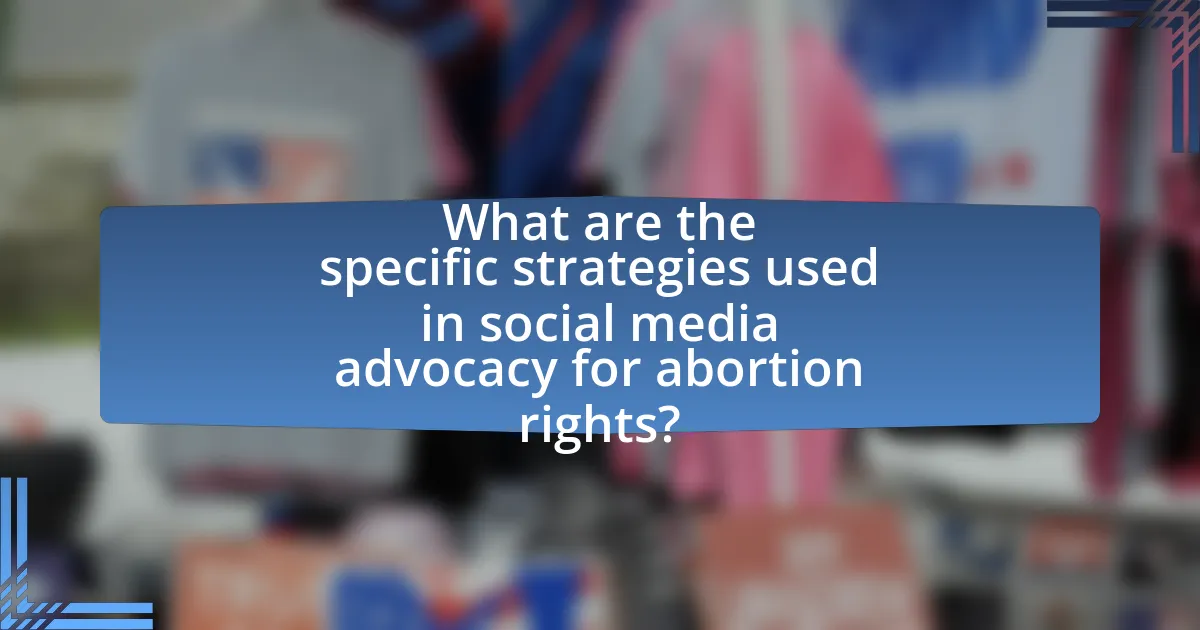
What are the specific strategies used in social media advocacy for abortion rights?
Social media advocacy for abortion rights employs specific strategies such as storytelling, hashtag campaigns, and influencer partnerships. Storytelling allows individuals to share personal experiences, creating emotional connections that resonate with audiences and humanize the issue. Hashtag campaigns, like #ShoutYourAbortion, mobilize users to collectively express support and raise awareness, amplifying the message across platforms. Influencer partnerships leverage the reach of well-known figures to engage broader audiences, making the advocacy more visible and impactful. These strategies have been shown to increase engagement and foster community support, as evidenced by the significant online discussions and mobilization efforts surrounding key legislative changes in various regions.
How do hashtags and trends amplify abortion rights messages?
Hashtags and trends amplify abortion rights messages by increasing visibility and engagement across social media platforms. When users employ specific hashtags like #AbortionRights or #MyBodyMyChoice, these tags create a collective identity and facilitate the sharing of personal stories, statistics, and advocacy efforts. Research indicates that social media campaigns utilizing trending hashtags can lead to significant spikes in public discourse and awareness, as seen during the 2017 Women’s March, where the hashtag #WomensMarch reached millions, effectively mobilizing support for reproductive rights. This amplification effect is further supported by algorithms that prioritize trending content, ensuring that abortion rights messages reach broader audiences and foster community support.
What are some successful examples of hashtag campaigns?
Successful examples of hashtag campaigns include #ShoutYourAbortion, which encourages individuals to share their abortion stories, fostering community and reducing stigma. This campaign gained traction in 2015, leading to increased visibility and support for abortion rights. Another notable example is #MeToo, which, while broader in scope, has intersected with reproductive rights discussions by highlighting the importance of bodily autonomy. The #StopTheBans campaign, launched in 2019, specifically targeted restrictive abortion laws in the U.S., mobilizing activists and generating significant media coverage. These campaigns demonstrate the power of social media in advocating for abortion rights and influencing public discourse.
How do trends shape the conversation around abortion rights?
Trends significantly shape the conversation around abortion rights by influencing public perception and mobilizing advocacy efforts. Social media platforms amplify trending topics, allowing for rapid dissemination of information and personal stories that resonate with broader audiences. For instance, the #ShoutYourAbortion campaign has empowered individuals to share their experiences, challenging stigma and fostering community support. This trend has led to increased visibility of abortion rights issues, as evidenced by a 2019 study from the Guttmacher Institute, which found that social media discussions correlated with heightened public awareness and engagement in reproductive rights advocacy.
What types of content are most effective in engaging audiences?
Visual content, such as infographics and videos, is most effective in engaging audiences. Research indicates that posts with images receive 94% more views than those without, and videos can increase engagement rates by up to 1200%. Additionally, storytelling through personal narratives resonates deeply, fostering emotional connections and encouraging sharing. Data from the Pew Research Center shows that 69% of adults use social media to connect with others, highlighting the importance of relatable and impactful content in advocacy efforts.
How do visual elements enhance the impact of advocacy messages?
Visual elements significantly enhance the impact of advocacy messages by increasing engagement and retention among audiences. Research indicates that visuals can improve information retention by up to 65% compared to text alone, making messages more memorable. In the context of social media, platforms like Instagram and Twitter utilize images and videos to convey complex issues, such as abortion rights, in a more digestible format. For instance, infographics can succinctly present statistics about reproductive health, while powerful imagery can evoke emotional responses that drive action. This combination of visual storytelling and factual representation effectively mobilizes support and raises awareness, demonstrating the critical role of visual elements in advocacy efforts.
What role do personal stories play in advocacy efforts?
Personal stories play a crucial role in advocacy efforts by humanizing issues and fostering emotional connections. These narratives can effectively illustrate the real-life impact of policies, making abstract concepts more relatable and compelling. For instance, personal accounts shared on social media platforms have been shown to increase engagement and support for abortion rights, as they provide firsthand experiences that resonate with audiences. Research indicates that storytelling can enhance persuasion, with studies revealing that messages framed through personal experiences are more likely to influence public opinion and mobilize action.
How can data analytics improve social media advocacy efforts?
Data analytics can significantly enhance social media advocacy efforts by providing insights into audience behavior and engagement patterns. By analyzing metrics such as likes, shares, comments, and demographic data, organizations can tailor their messaging to resonate more effectively with their target audience. For instance, a study by Pew Research Center found that 69% of adults in the U.S. use social media, indicating a vast potential audience for advocacy campaigns. Furthermore, data analytics allows for real-time monitoring of campaign performance, enabling advocates to adjust strategies promptly based on what content generates the most engagement. This data-driven approach not only optimizes resource allocation but also increases the likelihood of reaching and mobilizing supporters for causes like abortion rights.
What metrics should advocates track to measure success?
Advocates should track engagement metrics, reach metrics, and conversion metrics to measure success in abortion rights advocacy. Engagement metrics include likes, shares, comments, and retweets, which indicate how well the content resonates with the audience. Reach metrics, such as impressions and follower growth, help assess the visibility of advocacy efforts. Conversion metrics, including petition signatures, donations, or event registrations, provide concrete evidence of the impact of advocacy campaigns. For instance, a study by the Pew Research Center found that social media campaigns significantly increase public engagement and awareness on social issues, reinforcing the importance of these metrics in evaluating advocacy effectiveness.
How can insights from data inform future campaigns?
Insights from data can inform future campaigns by identifying trends, audience preferences, and effective messaging strategies. Analyzing engagement metrics, such as likes, shares, and comments on social media posts related to abortion rights, reveals which topics resonate most with the audience. For instance, a study by the Pew Research Center found that 70% of social media users engage with content that aligns with their beliefs, indicating that targeted messaging can enhance campaign effectiveness. By leveraging this data, advocates can tailor their campaigns to address specific concerns and interests, ultimately increasing outreach and impact.
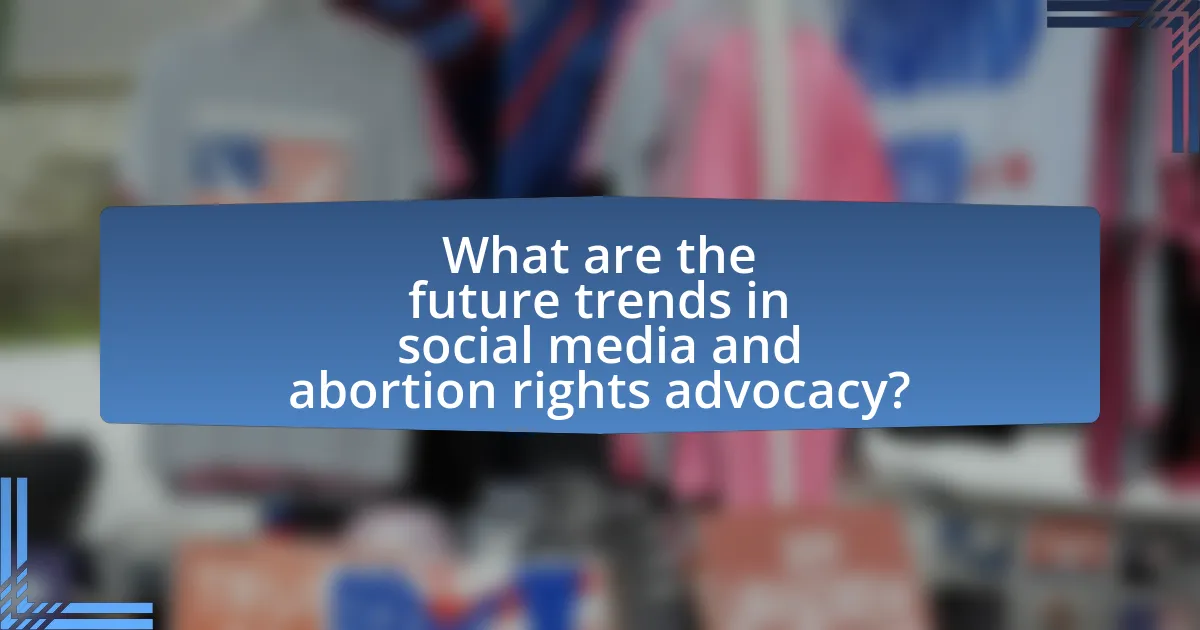
What are the future trends in social media and abortion rights advocacy?
Future trends in social media and abortion rights advocacy include increased use of digital platforms for grassroots mobilization and the integration of data analytics to target specific demographics. Social media will likely serve as a primary tool for real-time information dissemination, allowing advocates to respond swiftly to legislative changes and public sentiment. For instance, platforms like Twitter and Instagram have already been utilized to organize protests and share personal stories, which can enhance community engagement and awareness. Additionally, the rise of video content on platforms such as TikTok is expected to play a significant role in reaching younger audiences, making complex issues more relatable and accessible. Data from the Pew Research Center indicates that 69% of adults in the U.S. use social media, highlighting its potential as a powerful advocacy tool.
How is technology evolving to support advocacy efforts?
Technology is evolving to support advocacy efforts by enhancing communication, mobilization, and fundraising capabilities. Social media platforms, such as Twitter and Instagram, allow advocacy groups to reach wider audiences quickly, facilitating real-time engagement and information dissemination. For instance, the #ShoutYourAbortion campaign effectively utilized social media to normalize conversations around abortion, garnering significant public support and awareness. Additionally, data analytics tools enable organizations to target specific demographics, optimizing outreach strategies. According to a 2021 report by the Pew Research Center, 69% of adults in the U.S. use social media, highlighting its potential as a powerful tool for advocacy.
What emerging platforms could play a role in future advocacy?
Emerging platforms that could play a role in future advocacy include TikTok, Clubhouse, and Discord. TikTok’s short-form video content allows for rapid dissemination of advocacy messages, engaging younger audiences effectively; for instance, campaigns like #ShoutYourAbortion have gained traction on the platform, demonstrating its potential for social movements. Clubhouse offers real-time audio discussions, enabling activists to host conversations and share experiences in an intimate setting, which can foster community and mobilization. Discord, originally a gaming platform, has evolved into a space for organizing and community-building, allowing advocacy groups to create dedicated servers for discussions and resource sharing, enhancing collaboration among supporters. These platforms are increasingly utilized for grassroots movements, showcasing their effectiveness in reaching diverse demographics and facilitating dialogue around critical issues like abortion rights.
How might changes in social media policies affect abortion rights discussions?
Changes in social media policies can significantly impact abortion rights discussions by altering the accessibility and dissemination of information. For instance, if platforms implement stricter content moderation policies, it may limit the sharing of pro-abortion rights content, thereby reducing visibility for advocacy groups and activists. Conversely, more lenient policies could facilitate broader discussions and mobilization efforts, as seen during the 2020 protests for racial justice, where social media played a crucial role in organizing and amplifying voices. Additionally, research indicates that social media serves as a vital tool for information exchange, with studies showing that 70% of users rely on these platforms for news related to reproductive rights. Thus, changes in policies directly influence the dynamics of public discourse surrounding abortion rights.
What best practices should advocates follow on social media?
Advocates should prioritize authenticity, engagement, and strategic messaging on social media. Authenticity builds trust with followers, as studies show that 86% of consumers value transparency from brands and organizations. Engaging with the audience through comments, shares, and direct messages fosters community and encourages dialogue, which is essential in advocacy. Additionally, using clear and concise messaging tailored to the platform enhances the effectiveness of communication; for instance, visual content can increase engagement rates by up to 650%. By adhering to these best practices, advocates can effectively mobilize support and raise awareness for abortion rights.
How can advocates ensure their messages are inclusive and respectful?
Advocates can ensure their messages are inclusive and respectful by actively engaging diverse communities and incorporating their perspectives into advocacy efforts. This approach involves conducting thorough research to understand the needs and experiences of various groups affected by abortion rights, including marginalized populations. For instance, studies show that inclusive messaging can increase support for reproductive rights by 20% among underrepresented demographics. Additionally, using language that is sensitive and avoids stigmatization fosters a respectful dialogue, which is essential for building trust and solidarity within the community.
What are effective ways to engage with followers and build a supportive community?
Effective ways to engage with followers and build a supportive community include creating interactive content, fostering open communication, and providing valuable resources. Interactive content, such as polls and Q&A sessions, encourages participation and makes followers feel involved. Open communication, through regular updates and responding to comments, builds trust and strengthens relationships. Providing valuable resources, like informative articles and support networks, empowers followers and enhances community support. Research shows that communities with high engagement levels report increased satisfaction and loyalty among members, highlighting the importance of these strategies in advocacy efforts.
